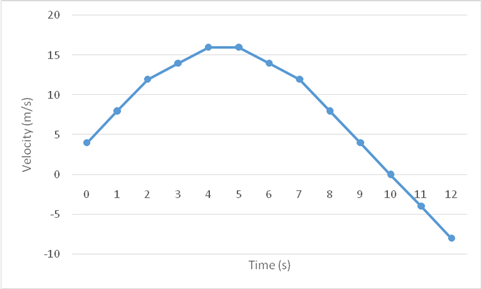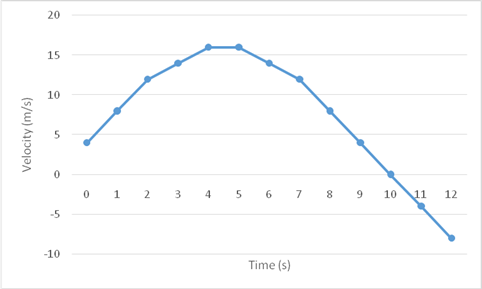
Concept explainers
(a)
To Plot:Velocity-time graph using the given table.
To Find: The time interval during which the object speeds up and slows down.
(a)
Explanation of Solution
Given:
| Time (s) | Velocity (m/s) |
| 0 | 4 |
| 1 | 8 |
| 2 | 12 |
| 3 | 14 |
| 4 | 16 |
| 5 | 16 |
| 6 | 14 |
| 7 | 12 |
| 8 | 8 |
| 9 | 4 |
| 10 | 0 |
| 11 | -4 |
| 12 | -8 |
Plot:

The object speeds up in from 0 to 4 s, then maintains constant speed between 4 s and 5 s. Thereafter, the object slows from 5 s to 10 s. The speed increases again.
(b)
To Find: The time at which the object reverses the direction.
(b)
Explanation of Solution
Introduction:

The object speeds up in from 0 to 4 s, then maintains constant speed between 4 s and 5 s. Thereafter, the object slows from 5 s to 10 s. The speed increases again.
At 10 s, it can be implied from the plot that the object changes the direction because the speed increase but in negative direction.
(c)
To Compare: The average acceleration between 0.0 to 2.0 s and 7.0 s and 12.0 s.
(c)
Explanation of Solution
Given:
| Time (s) | Velocity (m/s) |
| 0 | 4 |
| 1 | 8 |
| 2 | 12 |
| 3 | 14 |
| 4 | 16 |
| 5 | 16 |
| 6 | 14 |
| 7 | 12 |
| 8 | 8 |
| 9 | 4 |
| 10 | 0 |
| 11 | -4 |
| 12 | -8 |
Formula Used:
Average acceleration can be obtained by:
Here,
Calculations:
The average acceleration between 0.0 to 2.0 s:
The average acceleration between 7.0 s and 12.0 s:
Conclusion:
The average acceleration between 0.0 to 2.0 s is greater than that between 7.0 s and 12.0 s.
Chapter 3 Solutions
Glencoe Physics: Principles and Problems, Student Edition
Additional Science Textbook Solutions
Sears And Zemansky's University Physics With Modern Physics
Tutorials in Introductory Physics
Physics for Scientists and Engineers: A Strategic Approach, Vol. 1 (Chs 1-21) (4th Edition)
University Physics Volume 1
College Physics: A Strategic Approach (4th Edition)
Physics: Principles with Applications
 College PhysicsPhysicsISBN:9781305952300Author:Raymond A. Serway, Chris VuillePublisher:Cengage Learning
College PhysicsPhysicsISBN:9781305952300Author:Raymond A. Serway, Chris VuillePublisher:Cengage Learning University Physics (14th Edition)PhysicsISBN:9780133969290Author:Hugh D. Young, Roger A. FreedmanPublisher:PEARSON
University Physics (14th Edition)PhysicsISBN:9780133969290Author:Hugh D. Young, Roger A. FreedmanPublisher:PEARSON Introduction To Quantum MechanicsPhysicsISBN:9781107189638Author:Griffiths, David J., Schroeter, Darrell F.Publisher:Cambridge University Press
Introduction To Quantum MechanicsPhysicsISBN:9781107189638Author:Griffiths, David J., Schroeter, Darrell F.Publisher:Cambridge University Press Physics for Scientists and EngineersPhysicsISBN:9781337553278Author:Raymond A. Serway, John W. JewettPublisher:Cengage Learning
Physics for Scientists and EngineersPhysicsISBN:9781337553278Author:Raymond A. Serway, John W. JewettPublisher:Cengage Learning Lecture- Tutorials for Introductory AstronomyPhysicsISBN:9780321820464Author:Edward E. Prather, Tim P. Slater, Jeff P. Adams, Gina BrissendenPublisher:Addison-Wesley
Lecture- Tutorials for Introductory AstronomyPhysicsISBN:9780321820464Author:Edward E. Prather, Tim P. Slater, Jeff P. Adams, Gina BrissendenPublisher:Addison-Wesley College Physics: A Strategic Approach (4th Editio...PhysicsISBN:9780134609034Author:Randall D. Knight (Professor Emeritus), Brian Jones, Stuart FieldPublisher:PEARSON
College Physics: A Strategic Approach (4th Editio...PhysicsISBN:9780134609034Author:Randall D. Knight (Professor Emeritus), Brian Jones, Stuart FieldPublisher:PEARSON





